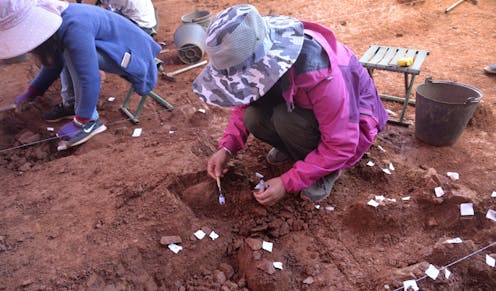Lynn and David Frohnmayer founded the Fanconi Anemia Research Fund in 1989 to help find a cure for their three daughters with Fanconi anemia, a rare, inherited condition typically diagnosed in children between the ages of 2 and 15 that leads to bone marrow failure and a life expectancy of about 20 years. In April 2024, the organization changed its name to the Fanconi Cancer Foundation (FCF), a sign of substantial progress in addressing bone marrow failure and extending the lives of patients. But patients who live longer face another significant issue—an extremely high risk of developing cancer.
Fanconi anemia is caused by mutations in one of 23 genes—including several cancer susceptibility genes such as BRCA1 and BRCA2—that impact the genes’ ability to function properly in the Fanconi anemia/BRCA DNA repair pathway. Compared to the general population, patients with Fanconi anemia are estimated to be around 868 times more likely to develop acute myelogenous leukemia (AML). Another study found that patients with Fanconi anemia are also 986 times more likely to get head and neck squamous cell carcinoma and have significantly higher chances developing tumors of the larynx, vulva, cervix, and breast.
“Many children with Fanconi anemia are now living longer but getting squamous cell cancers, so the current crisis is: What do we do with cancers that have a defect in this DNA repair pathway? How do we target that?” said Alan D’Andrea, MD, FAACR, a member of the scientific advisory board of FCF. “I am proud to be part of a very robust group of investigators in the field, but it is important to bring in a new investigator with a fresh look,” D’Andrea, who is director of the Center for DNA Damage and Repair and director of the Susan F. Smith Center for Women’s Cancers at Dana-Farber Cancer Institute, added.
To help encourage new researchers to join this field, FCF partnered with the American Association for Cancer Research (AACR) to launch the Fanconi Cancer Foundation-AACR NextGen Grant for Transformative Cancer Research. The grant will provide $450,000 over three years for expenses related to the research project. To apply, researchers must submit their letter of intent by July 9. To learn more about the current research being done in this field and the kinds of new ideas the committee behind this grant is looking to fund, we spoke with D’Andrea who has worked on Fanconi anemia for the last 30 years.
What has your own work in Fanconi anemia focused on?
Over the years, we have shown that the Fanconi anemia genes cooperate in a common DNA repair pathway, and if you knock out any of the members of this pathway, the cells exhibit sensitivity to certain drugs. That is why it is so insightful to study these rare inherited cancer susceptibility syndromes, because it often leads to broad insights into the treatment of any type of cancer. For instance, the Fanconi anemia pathway is disrupted in ovarian cancer, breast cancer, and prostate cancer—very common cancers. When the pathway is disrupted in those cancers from an acquired mutation, they tend to be more sensitive to drugs like PARP inhibitors, as one example.
This grant calls for a “highly innovative approach to a major contemporary challenge in Fanconi anemia-related cancer research.” What types of challenges should researchers look to address?
What we’re really trying to do with this grant is pull in a new investigator who maybe hasn’t worked on Fanconi anemia before but is interested in squamous cell cancers. Because right now there are not many good therapies for squamous cell cancer of the head and neck. So, the question is: Are squamous cell cancers in Fanconi patients and squamous cell cancers in the general population more sensitive to targeted therapies, immunotherapies, or other kinds of new treatments? We don’t know this yet, but we see this disease as a particularly ripe area for advancing new therapies for all squamous cell cancers.
What advice would you give to next-generation researchers?
Just enjoy the ride. I started working on Fanconi anemia as a young investigator 30 years ago and it’s been incredibly rewarding exploring this new biology. And I hope they recognize the opportunity to step in and do something really important for these families with Fanconi anemia and related squamous cell cancers. Once again, in so many other cancers, we already know that there’s a particular oncogene, kinase, or vulnerability, but we don’t know what that is yet for squamous cell cancers. We know some are HPV positive and some are HPV negative, but not how to exploit that in any kind of therapeutic way. So, there is a unique opportunity here.
Is there anything else researchers should know when preparing their applications for this grant?
While we welcome basic research, there should be a path to a translational outcome. So, a basic science investigator new to the field might want to collaborate with a clinician or translational investigator who could more quickly convert the basic science discovery into therapies. We’re also very interested in new ways to utilize pathology, spatial profiling markers, or artificial intelligence (AI) to help study these tumors and get some insights into their vulnerabilities. And since this is a disease of DNA repair, maybe this grant could entice an investigator to join the field who has a particularly strong focus on DNA repair biochemistry. Really, we are excited for any new ideas.
Those interested in applying can download a PDF for the full guidelines and instructions for submitting a letter of intent.
The post New Grant Will Fund Fanconi Anemia-related Cancer Research appeared first on American Association for Cancer Research (AACR).


